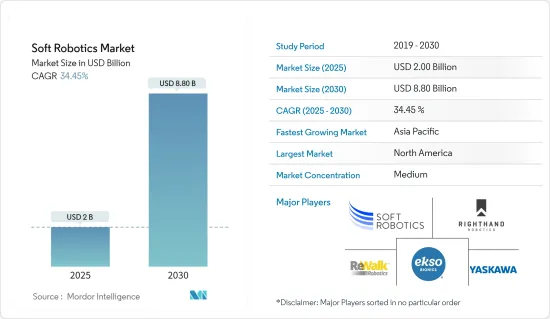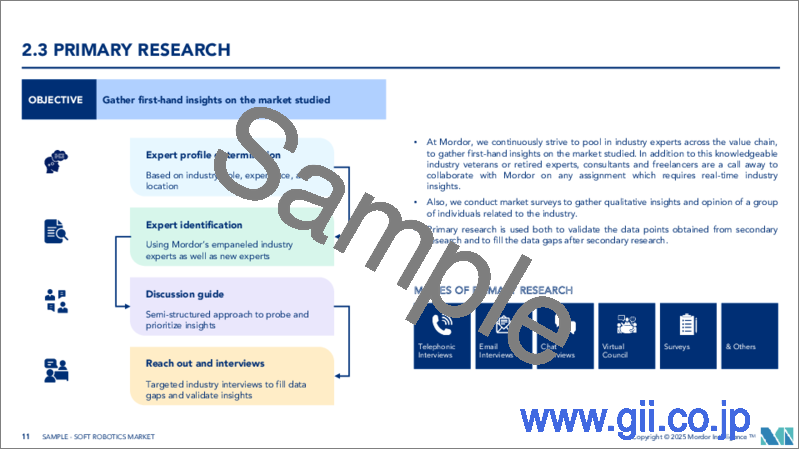|
|
市場調査レポート
商品コード
1641830
ソフトロボティクス-市場シェア分析、産業動向・統計、成長予測(2025年~2030年)Soft Robotics - Market Share Analysis, Industry Trends & Statistics, Growth Forecasts (2025 - 2030) |
||||||
カスタマイズ可能
適宜更新あり
|
|||||||
| ソフトロボティクス-市場シェア分析、産業動向・統計、成長予測(2025年~2030年) |
|
出版日: 2025年01月05日
発行: Mordor Intelligence
ページ情報: 英文 130 Pages
納期: 2~3営業日
|
全表示
- 概要
- 目次
ソフトロボティクス市場規模は2025年に20億米ドルと推定され、予測期間中(2025~2030年)のCAGRは34.45%で、2030年には88億米ドルに達すると予測されます。

主要ハイライト
- ソフトロボティクスはまだ初期段階にあるが、従来のロボティクスと比較してソフトロボティクスが提供する様々な利点により、予測期間中にソフトロボティクスの普及は飛躍的に伸びると予想されます。
- ソフトロボティクス市場の開拓を促進する要因としては、様々なエンドユーザー産業における安全性への要求の高まりや、食品加工、eコマースなどにおける自動化ニーズの高まりが挙げられます。複数の国で研究開発への投資/資金調達が増え続けていることが、ソフトロボティクス市場の成長に拍車をかけています。
- 外骨格は、倉庫や製造業で働く労働者を肩こり、腰痛、首の痛み、重いものを持ち上げたり繰り返したりすることによる怪我から守り、救う可能性を秘めた、新たな開発技術です。さまざまな研究者が、筋肉の動きを模倣したソフトでウェアラブルなロボティクスを開発しています。2021年5月、カナダのクイーンズ大学の研究チームは、歩行の代謝コストを削減する外骨格を開発しました。この研究は、歩行時に発生するブレーキ機能の一部を代替する外骨格を設計することで、歩行にかかる総代謝コストを削減することに基づいています。
- 医療用と非医療用外骨格は、ISO(国際標準化機構)/IECによって公表された国際的な安全規制要件に従う。これらの製品の商業化を成功させるためには、メーカーはこれらの規制を遵守しなければならないです。また、承認の機会は主観的なものです。また、認可の可能性は主観的なものであり、機器がその用途に適しているという合理的な保証がある場合にのみ達成されます。このような理由と、一元的な規制機関が存在しないため、商品化の時期が遅れ、市場の潜在的成長を抑制しています。
- 様々な企業が、硬いロボティクスでないと破損する可能性のある壊れやすい食品に最適な、柔らかい空気圧駆動グリッパーの開発に注力しています。食品は、労働力不足と疾病トランスミッションの懸念から、パンデミック時に自動化への関心が高まる主要な対象となっています。2021年6月、ソフトロボティクス企業はパンデミック関連の需要を挙げ、画期的なソフト把持、3D知覚、AI技術の研究開発のために1,000万米ドルを調達しました。
ソフトロボティクスの市場動向
医療外科用途が最も高い成長を記録する見込み
- ソフトロボティクスデバイスは、心血管疾患、大動脈弁狭窄症、ALSのような疾患による四肢障害などの治療やシミュレーションを支援することができます。虚血性心疾患における心臓再生の標的治療を改善する可能性もあります。国連人口基金によると、2050年にはインド全土の高齢者の心臓病患者数は約1,910万人になると予測されています。このような事例は、研究市場の需要を増大させる可能性が高いです。
- ソフトロボティクスは本来、人間や生物の自然組織に適合するという利点があります。低侵襲手術(MIS)は、ソフトロボティクスを採用する可能性が大きい研究セグメントの一つです。自由度の低さなど、従来のMIS法の限界を克服できるからです。
- 開腹手術や腹腔鏡手術の限界とロボティクス手術システムの利点の増加は、世界中でロボティクス支援手術の採用率を押し上げると予想されます。人体へのソフトロボティクス手術は、低侵襲手術(MIS)用に特別に設計された用途を持つ軟体動物から着想を得ており、現在のキーホール手術技術では外科医がこれまでアクセスできなかった領域を開拓しています。同じような研究が複数の研究者ラボや医療技術企業で活発に行われており、新しいソフトロボティクスの革新は、医師が手術を行う方法を形作ることになると考えられます。
- 2022年5月にIEEEが実施したソフトロボティクス支援低侵襲手術(RAMIS)とインターベンションに関する研究によると、狭い切開創で手術を行う腹腔鏡手術の登場により、外科界では従来の開腹手術からの急速な移行が見られました。ハンドヘルド器具からRAMISへの切り替えは、次の論理的なステップでした。外科医は、ロボティクスと直感的なユーザーインターフェースの助けを借りて、複雑な外科手術を容易に行うことができ、開腹手術の容易にアクセスできる状況を部分的に再現することができました。
- さらに、生体適合性のある軟質材料、超弾性材料、シリコーンエラストマーなどの3Dプリンティング軟質プラスチックにより、手術中の安全性を高めることができます。これらは、触覚に反応してロボティクスの形態や機械的特性を変化させることができるため、より本質的な安全性を高めることができます。このような開発は、ソフトロボティクスの範囲を拡大し、腹腔鏡手術、単孔式腹腔鏡手術などの低侵襲手術の手技に関連する可能性が高いです。
- 2022年1月、ベンチマークはTitan Medicalと製造供給契約を締結し、Titanのエノスロボティクスワークステーションとシングルポート手術システム用の患者用カートを製造すると発表しました。同社が選ばれた理由は、複雑な医療機器の設計、製造、組み立てにおける経験と垂直統合、需要に応じた生産規模の拡大能力です。同社は製造ソリューションをタイタンのカメラや多関節器具と統合し、2023年開始予定のヒト検査で使用する手術用ワークステーションや患者用カートの製造という目標達成を支援しています。
- ロボティクス手術市場は、泌尿器科、婦人科、整形外科などの慢性疾患の世界の罹患率の増加から恩恵を受けると期待されています。世界保健機関(WHO)の最新報告によると、心血管疾患、がん、糖尿病、慢性呼吸器疾患などの非感染性疾患(NCDs)は、世界の死亡原因のほぼ71%を占めています。毎年4,100万人がこれらのNCDsで死亡しています。
予測期間中、アジア太平洋が最速の成長を記録する見込み
- ソフトロボティクスは、生体組織に匹敵する機械的特性を持つ材料で構築されたシステムです。これらのロボティクスは、従来のロボティクスよりも革新的であると本質的に想定されています。アジア太平洋は、研究市場においていくつかの先進的なイノベーションを確認しています。
- 例えば2023年1月、中国科学院寧波材料技術工学ラボの陳涛教授率いるスマートポリマー材料グループは、浙江大学の鄭銀飛教授と協力して、ハイドロゲルをベースとした適応変形可能なソフトロボティクスを開発し、自然地形での多次元オフロード走行を実現しました。このグローブは、指や手に怪我を負った人の指の筋肉の動きを補助し、手で握る感覚をサポートすることが期待されています。
- アジア太平洋は、ソフトロボティクスの市場が最も急速に成長している地域のひとつです。この地域のベンダーは、ソフトロボティクスセグメントの技術革新と開発においても重要な役割を果たしています。2023年5月、マサチューセッツ工科大学(MIT)の研究チームは、エンジニアがソフトロボティクスの共同設計を研究できるようにする、生物学に着想を得たプラットフォーム、SoftZooの開発に向けて一歩を踏み出しました。このフレームワークは、ロボティクスの外観を決定するデザインと、ロボティクスの動きを可能にする制御システムからなるアルゴリズムを最適化し、ユーザーが潜在的な機械のアウトラインを自動的に生成する方法を強化します。
- 2022年9月、中国の研究チームは、人体内を移動し、さまざまな健康状態に対応することができる、磁力によって駆動する強力な変形デバイスであるマイクロロボティクスを開発しました。長さわずか1ミリのこの高性能ソフトロボティクスは、心臓血管疾患の治療のために血管内で跳ねたり、もがいたりすることができると主張されています。
- 食品の組み立ては、アジア太平洋で潜在的に大きな市場です。シンガポール工科大学の研究者たちは、このような作業が繰り返されがちな製造・組立作業の効率を改善するために、ソフトロボティクスを利用する機会を見出しました。2023年3月、A*STARのナショナル・ロボティクス・プログラムからの資金援助を受けて、研究者たちは再構成可能なワークスペースソフト(RWS)ロボティックグリッパーを開発しました。ロボティクスハンドに最適化されたマシンビジョンは、システムに設定された「ワークスペース」に適応するため、RWSロボティック・グリッパーは、さまざまなアイテムをすくい上げ、把持する能力を備えています。
- さらに日本では、政府が大学や企業と協力して、医師がより正確に手術を行い、同時にMRIの測定値や他の機器からのデータをモニターできるロボティクス手術システムの開発を進めています。さらに、2022年10月には、日本の筑波大学の研究チームが、痛みや不快な医療処置を受ける際の患者のストレスや恐怖を軽減するために、患者が対話できるソフトロボティクスを開発しました。
ソフトロボティクス産業概要
ソフトロボティクス市場は、技術面で巨額の投資が行われており、新規参入企業の出現が期待されています。現在、ソフトロボティクスメーカーは非常に特殊なソリューションを持っており、市場競争は中程度です。しかし、ロボティクス市場に大手企業が登場したことで、ソフトロボティクスへの参入は競争を激化させると予想されます。
- 2024年2月-受注完了のための自律型AIロボティクスピッキングソリューションのリーダーの一人であるRightHand Roboticsは、ワークスペース製品とソリューションの南北アメリカリーダーの一人であるStaples Inc.との複数年契約を発表。この契約により、Staples IncはRightPickアイテムハンドリングシステムを導入し、より高いサービスレベルと米国の98%以上に翌日配達を実現するためのオペレーションを自動化することができます。
- 2023年12月-ReWalk Robotics, Ltd.は、神経疾患患者のリハビリや日常生活におけるモビリティとウェルネスを可能にする革新的技術のリーディングプロバイダーの1社であり、概念実証の次世代外骨格のデモンストレーションに成功したと発表しました。
その他の特典
- エクセル形式の市場予測(ME)シート
- 3ヶ月間のアナリストサポート
目次
第1章 イントロダクション
- 調査の前提条件と市場定義
- 調査範囲
第2章 調査手法
第3章 エグゼクティブサマリー
第4章 市場洞察
- 市場概要
- 産業バリューチェーン分析
- 産業の魅力-ポーターのファイブフォース分析
- 新規参入業者の脅威
- 買い手の交渉力
- 供給企業の交渉力
- 代替品の脅威
- 競争企業間の敵対関係の強さ
- マクロ経済動向の市場への影響評価
第5章 市場力学
- 市場促進要因
- より安全なオートメーションソリューションへのニーズ
- 製造現場における人的安全の必要性
- 各国からの研究開発の増加
- 市場抑制要因
- 認識不足と一元的な規制機関
第6章 技術スナップショット
第7章 市場セグメンテーション
- 用途別
- ヒューマンマシンインターフェースとインタラクション
- 運動と探索
- マニピュレーション
- 医療手術用途
- リハビリ・ウェアラブルロボティクス
- 地域別
- 北米
- 欧州
- アジア
- オーストラリア・ニュージーランド
- ラテンアメリカ
- 中東・アフリカ
第8章 競合情勢
- 企業プロファイル
- Soft Robotics Inc
- RightHand Robotics Inc
- Ekso Bionics Holdings Inc
- Rewalk Robotics Ltd
- Yaskawa Electric Corporation
- Bioservo Technologies AB
- Festo AG
- Roam Robotics
- ABB Ltd.
- Pneubotics Inc
第9章 投資分析
第10章 市場機会と今後の動向
The Soft Robotics Market size is estimated at USD 2.00 billion in 2025, and is expected to reach USD 8.80 billion by 2030, at a CAGR of 34.45% during the forecast period (2025-2030).

Key Highlights
- Though soft robotics is still in its early stages, with the variety of benefits offered by soft robots compared to traditional robots, the penetration of soft robots is expected to grow dramatically over the forecast period.
- Factors driving the development of the soft robotics market include the increasing demand for safety across the various end-user industries and the growing need for automation in food processing, e-commerce, etc. The ever-increasing investments/funding in research and development across multiple nations is fueling the growth of the soft robotics market.
- Exoskeletons are an emerging developing technology that has the potential to protect and save warehouse and manufacturing workers from shoulders, back pain, neck pain, and injuries related to heavy and repetitive lifting. Various researchers are developing soft, wearable robots that mimic muscle movements. In May 2021, a team of researchers at Queen's University in Canada developed an exoskeleton that reduces the metabolic cost of walking. The research is based on designing an exoskeleton that obtains over some of the brakings that occur during walking, thereby reducing the total metabolic cost of walking.
- Medical and non-medical exoskeletons are subjected to international safety regulatory requirements published by ISO (International Organization for Standardization)/IEC. For successful commercialization of these products, manufacturers must comply with these regulations. Also, the chances for approval are subjective. They can be achieved only if there is a reasonable assurance that the device is appropriate for its application. Because of these reasons and the lack of a single centralized regulatory body, the commercialization aspect is delayed, thus restraining the potential growth of the market.
- Various players have been focusing on developing soft, pneumatic-powered grippers ideal for fragile foodstuff that might be damaged by rigid robotics otherwise. Food has been a prime target for interest in automation during the pandemic due to labor shortages and fears of disease transmission. In June 2021, Soft Robotics company cited pandemic-related demand and raised USD 10 million for research and development in its revolutionary soft grasping, 3D perception, and AI technologies.
Soft Robotics Market Trends
Medical and Surgical Applications is Anticipated to Register Highest Growth
- Soft robotic devices can assist in treating or simulating conditions like cardiovascular disease, aortic stenosis, and limb disabilities causes by diseases like ALS. They have the potential to improve targeted therapy for cardiac regeneration in ischemic heart diseases. According to the United Nations Population Fund, the number of cases of heart disease in senior citizens across India in 2050 was forecasted to be about 19.1 million. Such instances are likely to augment the demand for the studied market.
- Soft robots inherently have the advantage of being compliant with the natural tissues of humans and living organisms. Minimally invasive surgery (MIS) is one of the research areas with the big potential of adopting soft robotics. This is because it overcomes the limitation of traditional MIS methods, such as a low degree of freedom.
- The limitations of open and laparoscopic procedures and the increasing advantages of robotic surgery systems are expected to boost the adoption rates of robot-assisted surgeries worldwide. Soft-robotic surgery on a human body has been inspired by soft-bodied animals with applications specifically designed for minimally invasive surgery (MIS), opening up areas previously inaccessible to surgeons using current keyhole surgery techniques. With similar research being active across multiple researcher labs, and medtech companies innovating new soft robots will likely shape how physicians perform surgeries.
- According to a study conducted on Soft Robot-Assisted Minimally Invasive Surgery (RAMIS) and Interventions by IEEE in May 2022, with the arrival of laparoscopic surgery, which is performed through narrow incisions, the surgical community saw a rapid move away from traditional open surgery. Switching from handheld instruments to RAMIS was the next logical step. Surgeons could easily perform complex surgical procedures with the help of robots and an intuitive user interface, partially replicating the easily accessible situation of open surgery.
- Furthermore, biocompatible soft materials, super elastic materials, and 3D-printed soft plastics such as silicone elastomers allow for greater safety during surgeries. These allow changes in robotic shape and mechanical properties in response to touch, thus enhancing their greater intrinsic safety. Such developments are likely to expand the scope of soft robotics and become relevant to procedures in minimally invasive surgery, such as laparoscopy, single port laparoscopy, etc.
- In January 2022, Benchmark announced a manufacturing and supply agreement with Titan Medical to manufacture patient carts for Titan's Enos robotic workstations and single-port surgical systems. The company was selected for its experience and vertical integration in designing, manufacturing, and assembling complex medical devices and its ability to scale production to meet demand. The company has integrated its manufacturing solutions with Titan's cameras and articulated instruments to help achieve its goal of manufacturing surgical workstations and patient carts for use in human studies scheduled to begin in 2023.
- The robotic surgery market is expected to benefit from the growing incidence of chronic diseases such as urology, gynecology, orthopedic, and other chronic disorders worldwide. According to the latest World Health Organization (WHO) report, non-communicable diseases (NCDs), such as cardiovascular disease, cancer, diabetes, and chronic respiratory diseases, are responsible for almost 71% of global deaths. It accounts for 41 million people dying each year of these NCDs.
Asia Pacific is Expected to Register the Fastest Growth During the Forecast Period
- Soft robots are systems constructed from materials that have mechanical properties comparable to those of living tissues. These robots are intrinsically assumed to be more innovative than conventional robots. The Asia Pacific region is witnessing several advanced innovations in the studied market.
- For instance, in January 2023, the Smart Polymer Materials Group led by Prof. CHEN Tao at the Ningbo Institute of Materials Technology and Engineering of the Chinese Academy of Sciences, in cooperation with Prof. ZHENG Yinfei at Zhejiang University, developed a hydrogel-based soft robot with adaptive deformation, realizing multi-dimensional off-road locomotion on natural terrains. Its creators expect that the glove would help people with finger or hand injuries by aiding the movement of finger muscles, helping them feel the grasp of holding with one's hands.
- Asia-Pacific is one of the fastest-growing markets for soft robotics mainly due to the massive adoption of the technology with increasing domestic production in the market. The regional vendors also play a significant role in the innovation and development in the soft robotics field. In May 2023, a team of MIT researchers took a step towards developing SoftZoo, a bio-inspired platform that allows engineers to study soft robot co-design. The framework optimizes algorithms that consist of design, which determines what the robot would look like, and control, or the system that allows robotic motion, enhancing how users automatically generate outlines for potential machines.
- In September 2022, a Chinese research team created a powerful micro robot, a shape-shifting device driven by a magnetic force that is able to travel within the human body and help address an array of health conditions. The high-performance soft robot, which is just a millimeter long, is claimed to be able to bounce or squirm within blood vessels to treat cardiovascular disease, among other potential applications.
- Food assembly is a potentially big market in the Asia Pacific region. The researchers from the Singapore University of Technology and Design saw an opportunity to use soft robotics to improve the efficiency of manufacturing and assembly operations - where tasks of this nature tend to be repetitive. In March 2023, with funding support from A*STAR's National Robotics Programme, the researchers came up with a reconfigurable workspace soft (RWS) robotic gripper. The robotic hand-optimized machine vision adapts to the 'workspace' configured in the system, so the RWS robotic gripper is equipped with the ability to scoop and grasp a wide range of items.
- Additionally, in Japan, the government is collaborating with universities and companies to develop a robotic surgery system that allows doctors to operate more accurately and simultaneously monitor MRI readings and data from other devices. Further, in October 2022, a team of researchers at the University of Tsukuba in Japan developed a soft robot that patients can interact with to decrease their stress and fear when undergoing painful or uncomfortable medical procedures.
Soft Robotics Industry Overview
The Soft Robotics Market has seen huge investments in the technical front, and new entrants are expected to emerge in the market. Currently, soft robot manufacturers have very specific solutions, and the market is moderately competitive. However, with the advent of big players in the robotics market, venturing into soft robotics is expected to increase the competition.
- February 2024 - RightHand Robotics, one of the leaders in autonomous AI robotic picking solutions for order completion, announces a multi-year agreement with Staples Inc., one of the Americas leaders in workspace products and solutions. The agreement allows Staples to deploy and install the RightPick item-handling system to automate operations for higher service levels and Next-Day Delivery to over 98% of the United States.
- December 2023 - ReWalk Robotics, Ltd., one of the leading providers of innovative technologies that enable mobility and wellness in rehabilitation and daily life for individuals with neurological conditions, announced the successful demonstration of a proof-of-concept next-generation exoskeleton.
Additional Benefits:
- The market estimate (ME) sheet in Excel format
- 3 months of analyst support
TABLE OF CONTENTS
1 INTRODUCTION
- 1.1 Study Assumptions and Market Definition
- 1.2 Scope of the Study
2 RESEARCH METHODOLOGY
3 EXECUTIVE SUMMARY
4 MARKET INSIGHTS
- 4.1 Market Overview
- 4.2 Industry Value Chain Analysis
- 4.3 Industry Attractiveness - Porter's Five Forces Analysis
- 4.3.1 Threat of New Entrants
- 4.3.2 Bargaining Power of Buyers
- 4.3.3 Bargaining Power of Suppliers
- 4.3.4 Threat of Substitute Products
- 4.3.5 Intensity of Competitive Rivalry
- 4.4 Assessment of the Impact of Macro Economic Trends on the Market
5 MARKET DYNAMICS
- 5.1 Market Drivers
- 5.1.1 Need for Safer Automation Solutions
- 5.1.2 Need for Human Safety in Manufacturing Units
- 5.1.3 Increased R&D From Various Countries
- 5.2 Market Restraints
- 5.2.1 Lack of Awareness and a Single Centralized Regulatory Body
6 TECHNOLOGY SNAPSHOT
7 MARKET SEGMENTATION
- 7.1 By Application
- 7.1.1 Human-machine Interface and Interaction
- 7.1.2 Locomotion and Exploration
- 7.1.3 Manipulation
- 7.1.4 Medical and Surgical Applications
- 7.1.5 Rehabilitation and Wearable Robots
- 7.2 By Geography
- 7.2.1 North America
- 7.2.2 Europe
- 7.2.3 Asia
- 7.2.4 Australia and New Zealand
- 7.2.5 Latin America
- 7.2.6 Middle East and Africa
8 COMPETITIVE LANDSCAPE
- 8.1 Company Profiles
- 8.1.1 Soft Robotics Inc
- 8.1.2 RightHand Robotics Inc
- 8.1.3 Ekso Bionics Holdings Inc
- 8.1.4 Rewalk Robotics Ltd
- 8.1.5 Yaskawa Electric Corporation
- 8.1.6 Bioservo Technologies AB
- 8.1.7 Festo AG
- 8.1.8 Roam Robotics
- 8.1.9 ABB Ltd.
- 8.1.10 Pneubotics Inc






